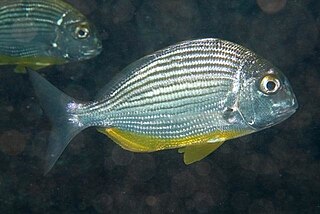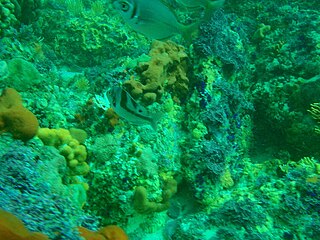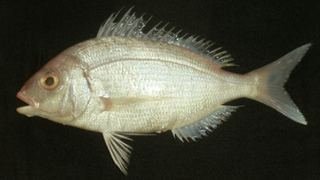
The panga, or panga seabream is a species of marine ray-finned fish belonging to the family Sparidae, which includes the seabreams and porgies. It is the only species in the monospecific genus Pterogymnus. This species is endemic to the coasts of South Africa. The panga is an important species in commercial line fisheries off South Africa.

Argyrops spinifer, the king soldierbream, Bowen snapper, long-spined red bream, longfin snapper, longspine seabream and red bokako, It is a species of marine ray-finned fish belonging to the family Sparidae. This species is found in the Indian Ocean.

Acanthopagrus is a genus of marine ray-finned fishes belonging to the family Sparidae, the sea breams and porgies. The fish in this genus are found in the Indian and western Pacific Oceans.

Polyamblyodon gibbosum, the knife-back seabream or cristie, is a species of marine ray-finned fish belonging to the family Sparidae, which includes the seabreams and porgies. This species is endemic to the southwestern Indian Ocean.

Crenidens crenidens, the karanteen seabream or karanteen, is a species of ray-finned fish from the sea bream family Sparidae which was described by the Swedish zoologist Peter Forsskål in 1775. It is native to the western Indian Ocean but has colonised the eastern Mediterranean Sea since 1970. It is one of only three species in genus Crenidens, the others being the little known Crenidens macracanthus and the partially sympatric C. indicus.

Crenidens is a small genus of three species of seabream from the family Sparidae from the western Indian Ocean. It was previously regarded as monotypic, with the sole species being the Karenteen sea bream Crenidens crenidens but two other species are now accepted as valid species, separate from the type species, C. crenidens.

Argyrops is a genus of marine ray-finned fishes belonging to the family Sparidae, the seabreams and porgies. These fishes are found in the coasts of Indian Ocean and near Australia.

Chrysoblephus anglicus, the Englishman seabream, is a species of marine ray-finned fish belonging to the family Sparidae, the seabreams and porgies. This fish is endemic to Southern Africa.
Crenidens macracanthus, Günther's karanteen, is a species of marine ray-finned fish belonging to the family Sparidae, which includes the seabreams and porgies. This fish is found in the Indian Ocean.

Rhabdosargus thorpei, the bigeye stumpnose, is a species of marine ray-finned fish belonging to the family Sparidae, which includes the seabreams and porgies. The bigeye stumpnose is endemic to the southwestern Indian Ocean.

Spicara axillare, the windtoy, is a species of marine ray-finned fish belonging to the family Sparidae, the seabreams and porgies. This species is found in the Western Indian Ocean and is endemic to South Africa.

Chrysoblephus cristiceps, the daggerhead seabream or dageraad, is a species of marine ray-finned fish belonging to the family Sparidae, the seabreams and porgies. This fish is endemic to the southwestern Indian Ocean and southeastern Atlantic Ocean off South Africa. This species is assessed as being Critically Endangered bt the International Union for Conservation of Nature.

Spondyliosoma emarginatum, the steentjie seabream, is a species of marine ray-finned fish belonging to the family Sparidae, which includes the seabreams and porgies. This species is found in the southeastern Atlantic Ocean and the southwestern Indian Ocean off South Africa and maybe Madagascar.
Chrysoblephus lophus, the false red stumpnose or the false Englishman, is a species of marine ray-finned fish belonging to the family Sparidae, the seabreams and porgies. This species is endemic to the South African waters of the southwestern Indian Ocean.

Pagellus natalensis, the Natal pandora, is a species of marine ray-finned fish belonging to the family Sparidae, which includes the seabreams and porgies. This species is found in the southwestern Indian Ocean.

Acanthopagrus bifasciatus, the twobar seabream, is a species of marine ray-finned fish belonging to the family Sparidae, the sea breams and porgies. This species is found in the northwestern Indian Ocean.
Argyrops filamentosus, the soldierbream, is a species of marine ray-finned fish belonging to the family Sparidae, the seabreams and porgies. This fish is found in the Western Indian Ocean.

Pachymetopon grande, the bronze seabream or blue hottentot, is a species of marine ray-finned fishes belonging to the family Sparidae, which includes the seabreams and porgies. This species is found in the southwestern Indian Ocean. It is an important spoecies for recreational fisheries in South Africa and for subsistence fisheries too.

Pagellus affinis, the Arabian pandora, is a species of marine ray-finned fish belonging to the family Sparidae, which includes the seabreams and porgies. This species is found in the northern Western Indian Ocean.

Polyamblyodon germanum, the German seabream, is a species of marine ray-finned fish in the family Sparidae, which includes the seabreams and porgies. This species is found in the southwestern Indian Ocean.

















